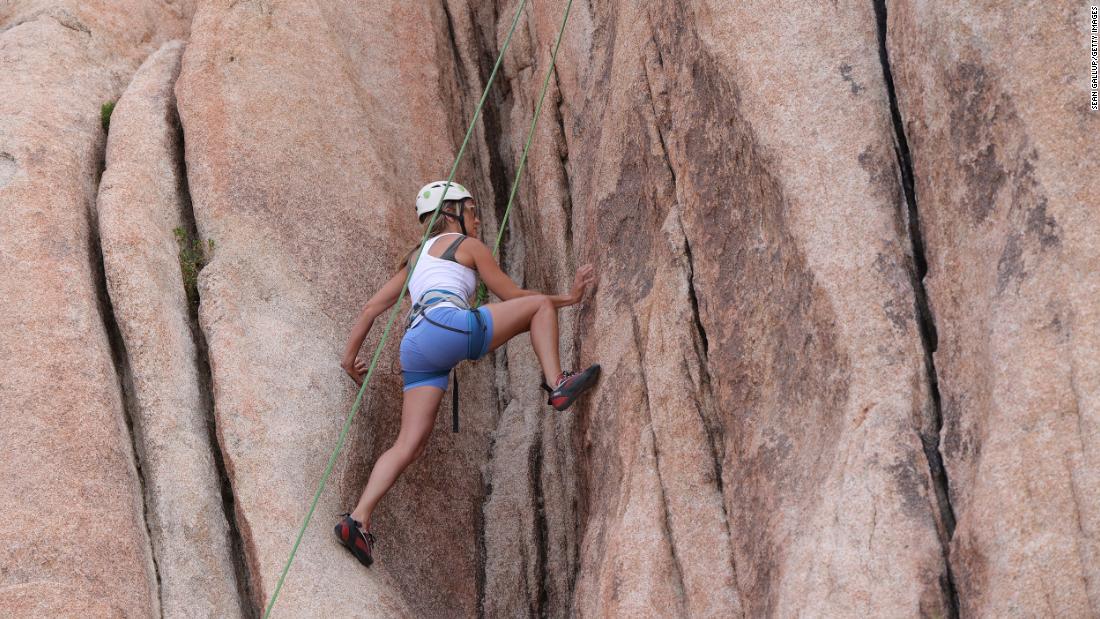
The new Olympic sport features three disciplines: bouldering, which is performed on lower walls without ropes; speed climbing, where the fastest person to the top wins; and lead climbing, where the goal is to climb as high as possible within a time limit.
While rock climbing attracts thrill-seekers, others appreciate it as an excellent workout that also calms and sharpens the mind.
Here are eight reasons you may wish to give rock climbing a try.
Important note: Before beginning any new exercise program, consult your doctor. Stop immediately if you experience pain.
Increases cardiorespiratory fitness
Builds muscle strength
“You build a lot of upper-body strength when you climb, especially in the hands and fingers,” DiCristino said. “But a lot of people don’t realize that if you’re using proper technique, your lower body gets quite a workout, too, with all of the squatting and jumping.”
Improves flexibility and balance
Climbing requires you to be able to stretch your arms and legs high and wide, plus contort your body into unusual positions. And, of course, you need to balance on tiny footholds. The more you climb, the better your flexibility, balance and coordination.
“Climbing helps you be aware of your body and improves the way you move your body,” said Nick Wilkes, owner and head instructor at Devils Lake Climbing Guides, a guide service in Madison, Wisconsin.
Enhances memory and problem-solving
Much of rock climbing’s skill lies in determining and memorizing your climbing route beforehand. You also need to be able to problem-solve on the fly, changing your route or sequences if you encounter unexpected obstacles. “Climbing is very cognitive in nature,” DiCristino said.
Boosts communication skills
Communication skills are essential to your safety. Roped climbers have a companion on the ground called a belayer, who handles the rope through a device to manage the tension or slack, catch any falls and lower the climber. Throughout a climb, the duo must constantly communicate about such concerns as desired rope tension, when the climber wants to rest and when it’s time to come down.
“In order for me to be a better climber, I have to communicate clearly with the person belaying me so they know how I’m feeling, when I need a break or if I want to change the climb in any way,” said Lindsay Wenndt, a certified health coach, fitness trainer and owner of Atlanta-based Break Free Fitness.
“The same is true if I’m the one holding the rope,” she said. “It’s my job to give encouragement when my partner feels she can’t do a certain move, point out a more efficient way to complete a route and be her biggest cheerleader when she crushes a new obstacle or goal.”
Enhances trust
Belaying — whether you’re the belayer or climber — involves a lot of trust since it’s essential to safety. “I have to trust my partner implicitly,” Wenndt said, knowing they’ve got her if she falls. “I also have to trust myself that I’m going to succeed in at least one thing on that route that I don’t think I can do.”
You can build trust more readily through climbing, compared with a lower-risk sport, Wilkes said. “Belaying someone, or being belayed, does have a life-or-death element to it,” he said. “This leads to a deeper experience for folks.”
Builds community
“When you go to a climbing gym, they often have sign-up boards where people are looking for a partner to climb with,” he said. “It’s a great way to meet people.”
Combats depression
Climbing is very reflective, too, Wilkes said. “It’s a great mirror that shows you how you deal with fear, disappointment and success, and how you deal with the rest of your life as well.”

